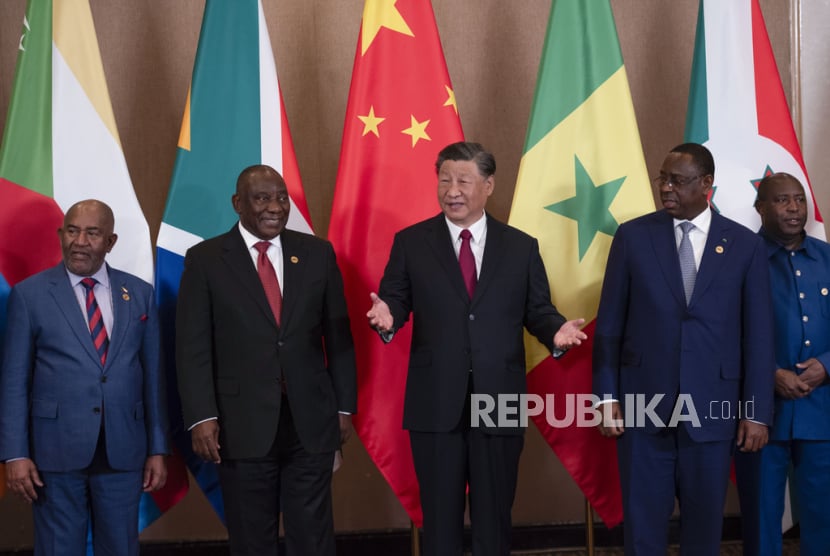
Oleh : Andi Kurniawan*
REPUBLIKA.CO.ID, JAKARTA -- BRICS has evolved to be more popular and attractive. Worsening geopolitical tension and increasing global economic challenges drive developing countries to seek alternate cooperation to secure future economies and development. BRICS stands for Brazil, Russia, India, China, and South Africa. These countries represent a considerable portion of the worldwide economy. More emerging economies, including Malaysia, Pakistan, El Salvador, and Belarus, have recently applied for BRICS membership.
It signals the growing optimism for more diverse and stable international cooperation among the developing economies amidst the geopolitical risks. However, to what extent will BRICS become an effective channel for dealing with various political and economic problems facing the developing world? This article argues that the effectiveness of BRICS institutions will substantially be influenced by the political behaviours of the key member countries.
Economic Power of BRICS
The institutionalization of BRICS brings new hopes for developing countries to develop equal and fair economic trade cooperation. It has been acknowledged that BRICS countries constituted more than 40% of the worldwide population in 2023. This figure emphasizes BRICS as a promising market for developing countries in a time of potential global trade shifts from the North-South to the South-South. In fact, the global foreign trade share of the four central BRICS countries has attained 17% in 2023, with a total foreign trade value of more than US$ 10 trillion. The share is forecasted to continue increasing with more new member countries joining the group.
The strength of the BRICS economy was further indicated by a substantial share of their GDP. In 2023, according to the World Bank database, the combined GDP of four BRICS countries reached US$ 25.9 trillion, which equalled 25% of the world’s GDP. The percentage is expected to increase in coming years, along with their robust economic performance, including the supply capability of high-demand natural resources such as soya beans (Brazil), petroleum oils (Russia), rice (India), and iron ore (South Africa). Interestingly, the abundant natural resources economy is also followed by their outstanding industrial value-added. In 2023, China was on the top list of countries with the largest industrial value-added worth US$ 6.8 trillion. Likewise, India and Russia were in the fifth and sixth positions, with industrial added value of US$ 887.8 billion and US$619.5 billion, respectively. This notable industrial-added value illustrates the industrial capability and productivity of BRICS countries, not only in natural resource business but also in other strategic sectors, such as construction and manufacturing.
Global Challenges to Protectionism
These economic indicators are essential to affirming the strategic positions of BRICS countries as future leaders in the global economy. The demand for alternative international institutions, especially for the Global South, sounds critical. The developed economies have signaled that they will continue protecting their economies, especially against China. The EU’s decision to impose import tariffs on China’s electric vehicles in the range of 17.4% to 37.6% is a setback from trade fairness and partnership.
The US trade policy to retain most of the Trump tariff administration and President Biden’s decision to set additional tariffs on Chinese goods such as semiconductors and electric vehicles will possibly worsen the global trade growth. It is undeniable that China has become one of the major trade partners for many developing countries. Those mercantilist trade approaches could harm China’s economic growth, resulting in a market slowdown for other developing countries.
Therefore, BRICS has emerged as the Global South's aspiration for more prosperous and inclusive international economic cooperation. BRICS could represent developing countries' voices in dealing with many crucial economic and political issues. The other also hopes that the rising international group could turn into a balancer against the major powers.
Obstacles: Russia, China’s Foreign Politics
However, achieving such big goals requires the solid capability of the leaders and consolidated support from all members. It has been introduced, for example, in the works of Heldt & Schmidtke (2017) and Vu (2017), that capability is a critical element of leadership in international organizations, both in the context of financial and economics and their capability of influencing other countries. Subsequently, the required leadership competency in modern international organizations is elaborated into the capacity to be inclusive and manage complexity (Goglea, 2022).
As previously described, BRICS undoubtedly has ample economic resources to contribute to the world’s economic development. Similarly, their potential power also appears in their military strength, especially in Russia, China, and India. The 2024 Military Strength Ranking by Global Fire Power has indexed these BRICS countries in the second, third, and fourth positions, respectively. The ranking assessed indicators ranging from military quantity data to financial and logistical capability. This tangible power is considered very influential in determining the direction of global politics and security.
Nevertheless, their inclusivity and the capability to manage complexity remain limited. In the case of Russia, the ongoing war between Russia and Ukraine has forced the world into a worse geopolitical scenario. The war is deeply rooted in Russia’s political interest in controlling Ukraine and preventing the enlargement of NATO and EU membership to include the country while neglecting international law, rules, and norms (Dodds et al., 2023). In the case of China, the country’s ten-dash line policy has resulted in the broader dispute between China and other Asian countries, including a recent violent clash between the China Coast Guard and the Philippine Navy in the South China Sea. It is counterproductive in the spirit of solidarity and integration of the Global South, which many expect China will be a generous leader willing to share its resources and protect others. It reminds us of the leadership concept in Confucianism that underscores the importance of people as the source of legitimacy and the leader as the engine of good governance (Jin, 2021).
In conclusion, BRICS continues to improve as an alternative power in a more fragmented world. The informal group has considerable economic potential and substantial military capability. Despite that, to what extent is the capability of BRICS to bridge and solve the Global South’s problem will also be influenced by the political behaviour of its leading countries, especially Russia and China, involved in critical disputes with other countries.
*A Lecturer of International Relations, UPN Veteran Jakarta, former research analyst at KADIN Middle East & OIC, and Dun & Bradstreet Indonesia.


